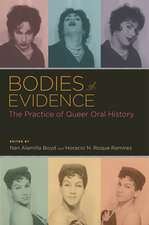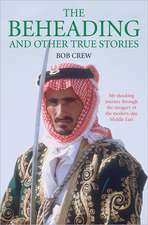Cuba: Latin America in Focus
Editat de Ted A. Henken, Miriam Celaya, Dimas Castellanosen Limba Engleză Hardback – 28 oct 2013 – vârsta până la 17 ani
Preț: 425.65 lei
Preț vechi: 730.10 lei
-42% Nou
Puncte Express: 638
Preț estimativ în valută:
81.46€ • 84.40$ • 67.98£
81.46€ • 84.40$ • 67.98£
Carte tipărită la comandă
Livrare economică 22 martie-05 aprilie
Preluare comenzi: 021 569.72.76
Specificații
ISBN-13: 9781610690119
ISBN-10: 1610690117
Pagini: 616
Ilustrații: 55 bw illus
Dimensiuni: 178 x 254 x 33 mm
Greutate: 1.2 kg
Editura: Bloomsbury Publishing
Colecția ABC-CLIO
Seria Latin America in Focus
Locul publicării:New York, United States
ISBN-10: 1610690117
Pagini: 616
Ilustrații: 55 bw illus
Dimensiuni: 178 x 254 x 33 mm
Greutate: 1.2 kg
Editura: Bloomsbury Publishing
Colecția ABC-CLIO
Seria Latin America in Focus
Locul publicării:New York, United States
Caracteristici
Provides an accurate, insider's perspective into contemporary Cuba supplied by Cubans who currently live and work on the island, in stark contrast with most accounts that are filtered through the lens of an outside observer
Notă biografică
Ted A. Henken, PhD, is associate professor in the Department of Sociology and Anthropology at Baruch College, City University of New York. His published work includes ABC-CLIO's Cuba: A Global Studies Handbook.Miriam Celaya is an independent journalist who regularly publishes articles in Diario de Cuba, Convivencia, and Voces magazine, and was a cofounder of the independent digital magazine Consenso (2004-2007).Dimas C. Castellanos writes for the digital publications Diario de Cuba, Convivencia, and Voces magazine. An independent journalist, he also publishes his own blog, "El Blog de Dimas" (www.desdecuba.com/dimas) and has won numerous journalism awards for his work.
Cuprins
Preface and Acknowledgments,1 Geography,Geographical Situation-"Cuba Is the Key,"Geographical Features,Topography,Geology and Mineral Deposits,Climate,Flora,Fauna,Endangered Species, Conservation, and Environmental Challenges,2 History,Cuba before Columbus,The Conquest and Colonization of Cuba,Velázquez, Las Casas, and Hatuey,Extermination or Assimilation-What Happened to Cuba's Native People?,Depopulation and Abandonment, 1540-1760,The Beginnings of the Slave Trade,The Pirates of the Caribbean and Havana's Fortifications and Walls,Cuban Coffee, Tobacco, and Sugar, and the Birth of Creole Proto-Nationalism,"La Prosperidad Británica": The British Capture of Havana, 1762-1763,The Cuban Creole Planters,Sugar and Slavery in Cuba during the 19th Century,Toward Independence and Emancipation: The Aponte and Escalera Conspiracies,The Slave Plantation,The Intellectual Foundations of Abolition and Independence: Varela, Saco, Del Monte, and Luz,Annexation and Rising U.S. Interest in Cuba,The Decline of the Plantation and the End of Cuban Slavery, 1880-1886,The Long Struggle for Independence and Its Aftermath, 1868-1901,The Ten Years' War,Antonio Maceo, the Protest of Baraguá, and the Fruitful Truce,The Little War, the Autonomists, and José Martí's Cuban Revolutionary Party (PRC),From the War of Independence of 1895 to the "Spanish-American War" of 1898,"Remember the Maine, to Hell with Spain!": The United States Enters the War,The Naval Battle of Santiago and the U.S. Occupation,The Plattist Republic, 1899-1934,The Platt Amendment: An Occupation without Occupiers,Cuban Electoral Politics, 1902-1925,The Movement for National Renewal,The Machadato, 1925-1933,The Revolution of 1933 and the Rise of Fulgencio Batista,Years of Hope and Betrayal, 1940-1952,The Constitution of 1940,The Cuban Democratic Experiment, 1940-1952,The Cuban Insurgency, 1953-1958: The Rise of Fidel Castro,From Moncada to Granma, 1953-1955,The Long Road from the Sierra Maestra to Havana, 1956-1958,A Peak behind the Insurrectionary Curtain,"The Revolution Begins Now": 1959-1961,The Dismantling of Civil Society,The Concentration of Ownership,3 Politics and Government,Introduction,Consolidation, Radicalization, and Charismatic Leadership, 1959-1970,Early Revolutionary Decrees,Mass Organizations,The Consolidation and Radicalization of the Revolution,Bureaucratic Authority, Institutionalization, and People's Power, 1970-1989,Cuba's Constitution and Legal System,Cuba's System of Government: The National Assembly, the Council of State, and the Council of Ministers,The Cuban Communist Party (PCC),The Cuban Electoral System and the Assemblies of People's Power,Cuba's International Relations,Economic Crisis, Reform, and Emergent Civil Society, 1990-2013,The Fourth Party Congress of 1991 and the Constitutional Revisions of 1992,The U.S. Embargo Today,Human Rights, Political Prisoners, and Opposition Groups,The Emergence of Civil Society,4 Economy,Introduction,Cuba's Economic History and the Socioeconomic Problems of the 1950s,Cuba's Close but Dependent Relationship with the United States,The Urban-Rural Divide,Economic Experimentation, Collectivization, and Institutionalization, 1959-1990,The State Takeover of the Economy and Implementation of the Central Plan, 1959-1963,Cuba's New International Economic Relations with the Soviet Bloc,Che Guevara, the "New Man," and the Great Debate,The Radical Experiment, the "Revolutionary Offensive," and the Gran Zafra, 1966-1970,Soviet Institutionalization and the Taming of Fidel Castro, 1970-1985,The Rectification Process, 1986-1989,From Reform to Retrenchment: Cuba Confronts the "Special Period," 1990-1996,Economic Retrenchment, Recentralization, and the Exit of Fidel Castro: 1996-2006,The Rise of Raúl Castro, 2006-2013,Agricultural Reforms and Their Limits,Pilot Privatization Programs and the Start of State Sector Layoffs,The Return of Self-Employment: Once More with Feeling?,The "Lineamientos" and Preparations for the Sixth Party Congress,The Sixth Congress of the Cuban Communist Party, April 2011,The Triumph of Raúl Castro and the Armed Forces,Modifications to the Self-Employment Regulations, May 2011,Future Reforms, Current Crises, and U.S.-Cuban Relations,Conclusion: The Deepening of Raúl's Reforms, September 2011,5 Society,Religion and Thought,Introduction,Religious Syncretism and National Identity,Catholicism,The Church of Impassioned Confrontation,The Church of Silence,The Church of Dialogue,African Religions,The Orishas,The Abakuá,Protestantism,Jehovah's Witnesses,Judaism,Islam,The Freemasons,Espiritismo,Ethnicity and Race, Class Structure, and Inequality,Ethnicity and Race,The Racial Problem,Transculturation, the One-Drop Rule, and the Myth of Racial Democracy,Urban versus Plantation Slavery,The Myths of Legal Equality and Black Inferiority,Race and Revolution,Class Structure,The Colonial Class Structure,Dependent Capitalism,°Viva el socialismo! Or Is It State Capitalism?,Inequality, Poverty, and Social Contradictions in Today's Cuba,Family, Gender, and Sexuality,Introduction,Family,The Cuban Family Today,Gender,Advances for Women during the Republic,The 1959 Revolution and the End of the Cuban Feminist Movement,Education,Historical Antecedents,Education during the Republican Period: Great Achievements and Great Inequality,Education during the Revolutionary Period: Institutionalized Voluntarism,The 1961 Literacy Campaign,Mass Mobilization Campaigns and Educational Experiments: Education or Indoctrination?,Between Quality and Quantity,Education in Cuba Today,The Return of Religious and Private Education?,Migration and Diaspora,Introduction,Immigration to Cuba during the Colonial Period,Immigration during the Republic,Cuban Emigration to the United States and the Creation of the Cuban Diaspora after 1959,The Beginnings of Emigration Controls,The Golden Exiles, Operation Peter Pan, Camarioca, and the "Freedom Flights,"The Mariel Boatlift,The Balsero Crisis,New Routes of Exit and Entry: Balseros, Boteros, El Bombo, and El Trampolín,The Cuban Diaspora in the 21st Century,A Profile of the Cuban-American Population Today,Three Paradoxes of the Cuban-American Community in the United States: Exiles or Immigrants?,The Media,The Official Version,Mechanisms of Control,The Other Side of the Page,The Jump to the Web,Internet, Social Media, and the Cuban Blogosphere,A 1.0 Island in a 2.0 World,Here Comes the Cable!,Internet without Internet,A Profile of a Cuban "Internaut,"The Institutionalists,The Ciber-cimarrones,The Soldiers of the Web,Twitter and Facebook,6 Culture,Introduction,Language and Literature,Language,Characteristics of Cuban Spanish,A Mestizo Language,Cuban Literature: The Avant-Garde versus the Vanguard,Colonial Literature,Literature of the Republic,Literature under the Revolution,Conclusion,Dance, Music, and Theater,Dance,Classical Ballet,Modern Dance,Folkloric Dance,The Rumba,Ballroom Dance,Music,Origins,Classical Music and Cuban Jazz,The Son,Crossover Success: From the Son to the Mambo, and Beyond,Cuban Music after 1959: Salsa, Nueva Trova, Songo, and Timba,Salsa,Nueva Trova,Songo and Timba,Cuban Music Today,Theater,Origins,Cuban Vernacular Theater,Havana, a City of Theaters,Cuban Theater after 1959,Conclusion,Cinema and Photography,Silent Film,Sound Film,Films after 1959,The ICAIC Takeover,PM and Castro's "Words to the Intellectuals,"Revolutionary Cinema,Cinema of the Marginal and Absurd,Alice in Wonderland,Cuban Cinema as a Cultural Event,Cuban Cinema Today,The History of Cuban Photography,Cuban Photography after 1959,Cuisine,Introduction,Typical Cuban Cuisine,Traditional Cuban Beverages,History and Antecedents of Cuban Cuisine,Native Foods,Early Inherited and Creole Foods,Immigrant Influences on Cuban Cuisine,Cuban Cuisine since the Revolution,Art and Architecture,Art,Painting,Painting after 1959,Architecture,Antecedents,Cuban Architecture from Colonial Times to the Revolution,Architecture during the Revolutionary Period,Popular Recreation and Sports,Pastimes,Cockfighting,The Lottery,Chess,Sports,Baseball,Boxing,Revolutionary Sports,Basketball,Volleyball,Track and Field,Fencing,Jaialai,Soccer,Popular Culture, Customs, and Traditions,Oral Tradition,Traditional Festivals,Local and Peasant Festivals,Parrandas and Charangas,Holguín's Romerías de Mayo and Cuba's Chinese-Origin Festivals,Cuban Carnival,Havana's Carnival,Santiago's Carnival,7 Contemporary Issues,Raúl Castro's Reforms: Two Steps Forward, One Step Back,Phase One,Phase Two,Phase Three,Results of the Three Phases,The Real Causes,Agricultural Reforms,Sugar,Coffee and Rice,Cattle,Political Reforms and Rising Corruption,The Innovative Aspects,The Limitations of the Reforms,The Problem of Corruption,Recent Cuban Elections,Cuba's Demographic Crisis,Recent Migration Reforms,Cuba's International Relations,Twenty-First Century Relations between Cuba and the United States,Socialism of the 21st Century: Cuba's Relations with Venezuela,Liberalization without Democratization: Cuba's Relations with China,The Catholic Church, Dissidence, Civil Society, and Human Rights,The Catholic Church in Dialogue with the Cuban Government,The Visit of Pope Benedict XVI, March 2012,Dissidence and Civil Society,Human Rights,Glossary,Facts and Figures,Major Cuban Holidays and Festivals,Country-Related Organizations,Annotated Bibliography,Thematic Index,Index,About the Authors and Contributors,
Recenzii
This book is written very honestly with thought-provoking facts about one of our more interesting Latin American neighbors. This title is recommended for large public libraries and academic libraries.













